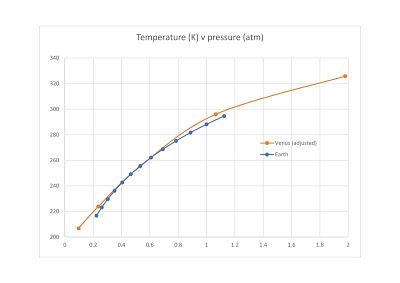Radical Rodent linked to this article comparing Earth's and Venus' atmospheres in the comments to this post.
The upshot is, all you need to know to work out the temperature at any altitude above any planet* is two things:
a) its distance from the nearest star ('the Sun' in the context of our Solar System), and
b) the atmospheric pressure at that altitude.
c) you do not need to adjust for, or even know, the 'albedo' of the planet, the composition of the atmosphere or anything else.
This farily recent article by completely different authors compares all planets in the Solar System which have a proper atmosphere and comes to the same conclusion. Our physics teacher mentioned this theory in passing when I did O-Level physics way back when, and I did see it mentioned every now and then since, so I assumed it was just an accepted scientific theory (or 'consensus' in NewSpeak). I'm not aware it's ever been seriously challenged in itself, but it would appear that it was simply written out of history fairly recently.
But Earth (atmosphere = 0.04% carbon dioxide) is of particular relevance because we live on it, and Venus is a useful comparison because its atmosphere = almost 100% carbon dioxide, which we are told causes 'a runaway greenhouse effect', plus the data is going to be most reliable, having been actually measured from up close, so let's focus on those two.
The results in the first article seemed suspiciously accurate, so I used other sources for the temperature v pressure gradients for Earth and Venus from here and here, made the 'divide by 1.176' adjustment for Venus (to compensate for the fact it is closer to the Sun) and knocked up a chart in Excel.
The tried and tested theory seems to stack up to me:

* Forgive the clunky wording, but Earth is clearly a (solid) planet with an atmosphere; while the gas giants are atmospheres without an actual planet.
